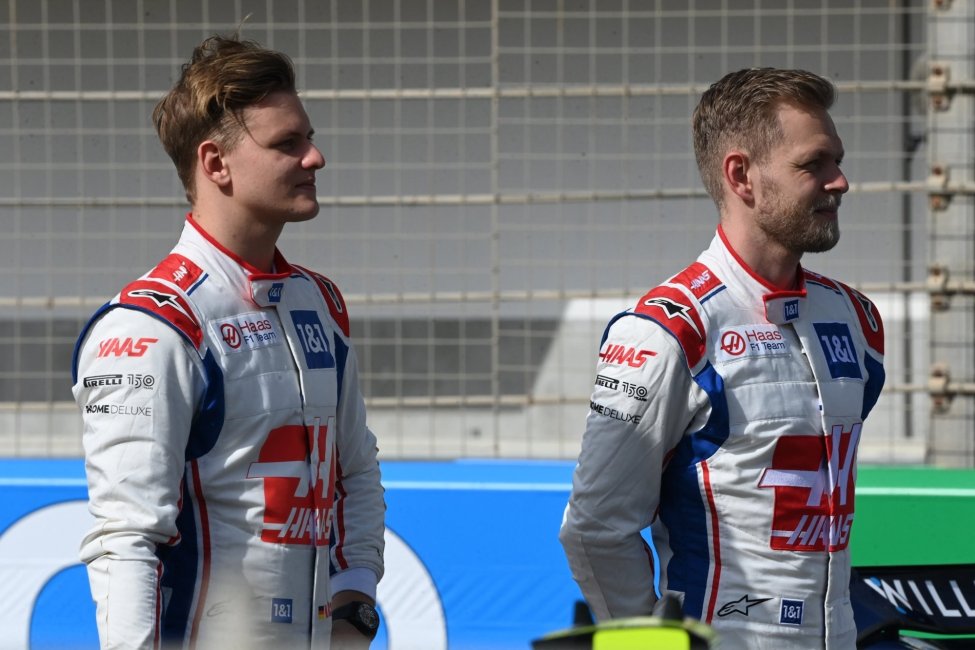



Kevin Magnussen
Haas F1
Kevin Magnussen has made a surprise F1 comeback in 2022, returning to Haas as a late replacement for Nikita Mazepin.
Biography of F1 driver Kevin Magnussen
After leaving Haas at the end of 2020, Kevin Magnussen’s F1 career seemed over and, like many others, he soon turned his hand to sports cars instead.
But with Russian sanctions turfing Nikita Mazepin out of the sport in February 2022, Haas quickly turned to their former driver as a late replacement, meaning Magnussen will be lining up on the 2022 grid to begin his seventh full season in Formula 1.
Here’s everything you need to know about Kevin Magnussen.
Ex-F1 driver’s son shows early promise
The son of 1990s F1 driver Jan Magnussen, Kevin began karting in his native Denmark before stepping up to single seaters in 2008, winning that year’s Danish Formula Ford championship in dominant fashion.
Moving up to Formula Renault 2.0 in 2009 with Motopark Academy, Magnussen finished runner-up to Antonio Felix da Costa in the Northern European Cup and finished seventh in the Eurocup.
Magnussen’s star was on the rise and the Dane was soon signed to McLaren’s young driver programme, echoing the career of his father, who raced for the Woking-based squad in the 1995 Pacific Grand Prix.
In 2010, Magnussen competed in German Formula 3 with Motopark, taking three wins on his way to third in the championship as the series’ top rookie.
Moving to British Formula 3 with Carlin in 2011, Magnussen took seven race victories to once again finish as the top rookie, placing behind only Felipe Nasr in the overall standings. The Dane also finished third in the Masters of Formula 3 race at Zandvoort, but crashed out of that year’s Macau Grand Prix.
Staying with Carlin for 2012, Magnussen raced in the Formula Renault 3.5 series alongside Will Stevens, taking one win and finishing seventh in the championship.
Remaining in the series for 2013, Magnussen moved over to the crack DAMS squad and took five victories on his way to the title after a year-long battle with Stoffel Vandoorne.
Graduating to F1 with McLaren
With Sergio Perez flattering to deceive at McLaren in 2013, the team elected to promote their long-time protege Magnussen to a race seat for 2014, and his debut race at Melbourne could hardly have gone better.
Qualifying fourth on the grid, Magnussen moved up to third after problems for Lewis Hamilton and stayed there until the end, later being bumped up to second following Daniel Ricciardo’s disqualification.
However, that was as good as it got for Magnussen at McLaren, as the team would slip back into the midfield for the rest of the season, with the Dane ending the year 11th in the Drivers’ Championship.
Worse was to come for Magnussen at the end of the year. With Fernando Alonso joining the team for 2015 and teammate Jenson Button electing to continue in F1, there was suddenly no room for Magnussen and he was demoted to a test driver role.
A pre-season injury for Alonso meant that Magnussen headed to the season opener as a race driver, but failed to take the start as the team suffered the first of many problems with its new Honda power unit.
Shunted onto the sidelines for the rest of the year, McLaren then ended their association with Magnussen altogether, and his F1 future looked in doubt before he was thrown a lifeline at Renault to replace Pastor Maldonado, whose sponsorship money had failed to materialise.
A lifeline at Renault before security at Haas
With Renault’s R.S.16 having its roots in an underfunded and underdeveloped Lotus design, Magnussen did not have much opportunity to impress in 2016, and his best result was seventh place at Sochi, though he did outscore teammate Jolyon Palmer.
Seeking greater career stability, Magnussen signed a three-year deal at Haas for 2017, becoming the first driver in F1’s turbo-hybrid era to have driven with Mercedes, Honda, Renault and Ferrari power units.
Three points finishes in the first eight races were followed by two more later in the year as Magnussen finished 14th in the standings, but by this point he was also beginning to gain a reputation among other drivers for being excessively aggressive on track.
In Hungary, Nico Hulkenberg branded Magnussen the “most unsporting driver” after an incident in which the Dane had run the German off the road, and Fernando Alonso was another to criticise Magnussen’s driving style in 2017, alleging that he had weaved to protect his position during the Malaysian Grand Prix.

The Haas experience turns sour
Remaining with Haas for 2018, the American team’s VF-18 was a vast improvement on its predecessor, enabling Magnussen and teammate Romain Grosjean to fight for regular points.
A brace of fifth places and nine other top-10 finishes saw Magnussen finish a solid ninth in the final standings with 56 points, five places and 19 points ahead of Grosjean.
However, Magnussen once again drew the ire of several drivers for his aggressive approach, with Alonso, Pierre Gasly and Charles Leclerc among those to take exception to Magnussen’s racecraft in 2018.
Magnussen and Grosjean continued together at Haas for a third season in 2019, but the VF-19 was not as competitive as its predecessor, and the pair were resigned to scrapping for occasional points in the lower reaches of the grid.
Nonetheless, Magnussen again outscored Grosjean, this time by 20 points to eight, but the two were notably involved in an embarrassing incident at Silverstone when they clashed on the opening lap, forcing both out of the race and precipitating an angry outburst from Team Principal Guenther Steiner.
Haas’ decline continued into the pandemic-affected 2020 season, with Magnussen scoring only a single point all year long. With the team’s financial situation worsening, Magnussen and Grosjean were moved aside at the end of the year in favour of the rookie duo of Mick Schumacher and the well-backed Nikita Mazepin.

© Haas
An unexpected return to F1
With his F1 career seemingly over, Magnussen turned his attention to sports cars for 2021, driving a Cadillac for Chip Ganassi in the American IMSA series, and also making a cameo IndyCar appearance at Road America in place of the injured Felix Rosenqvist.
Entering 2022, Magnussen was set to continue in IMSA with Ganassi, and had also signed on to drive for Peugeot in the World Endurance Championship in the French firm’s return to that series.
However, those plans were upended by Russia’s invasion of Ukraine in February, with the subsequent sanctioning of Russian individuals and institutions resulting in Mazepin losing his seat at Haas.
Things moved quickly behind the scenes, and within a few days of Mazepin’s dismissal, it was announced that Magnussen had extricated himself from his sports car contracts and rejoined Haas on a ‘multi-year’ deal in time for F1’s second three-day pre-season test session at Bahrain.
With Haas having essentially written off 2021 in preparation for Formula 1’s new technical regulations for 2022, the VF-22 showed well in testing at the hands of Magnussen and Schumacher, and the Dane may be confident of scoring regular points again as he makes an unlikely return to an F1 race seat.

